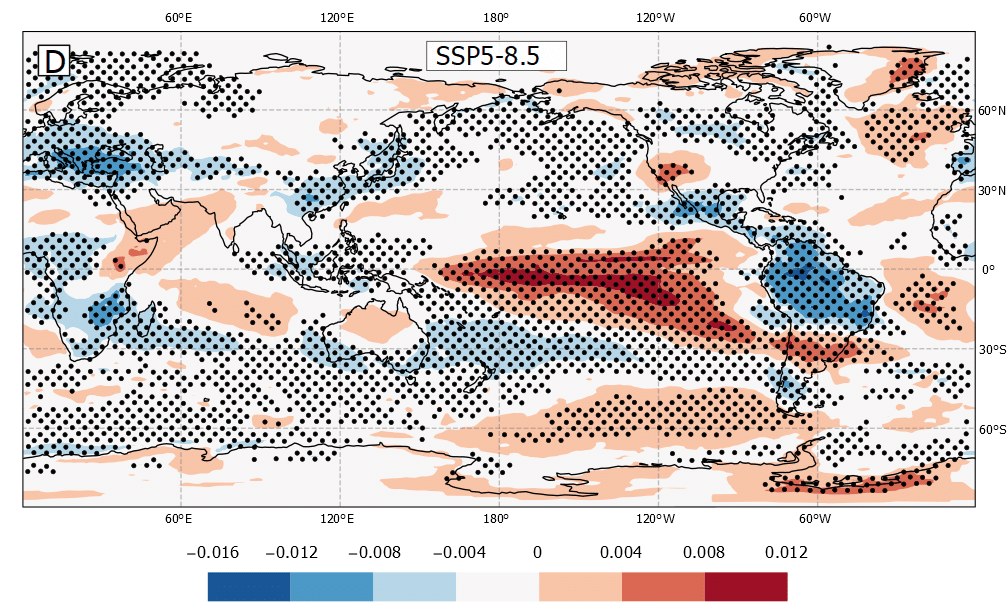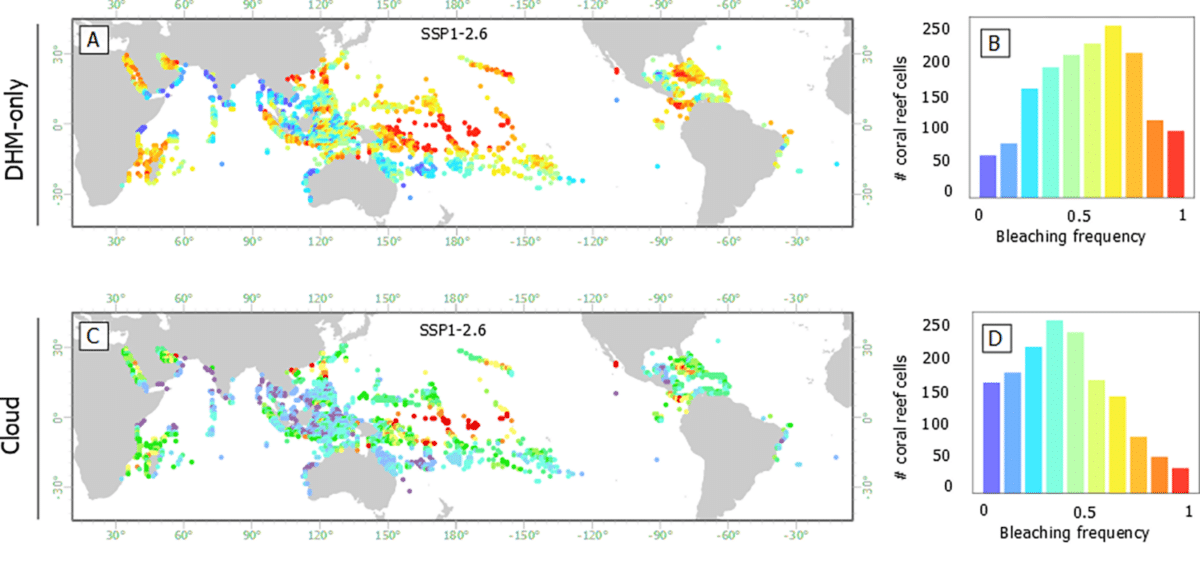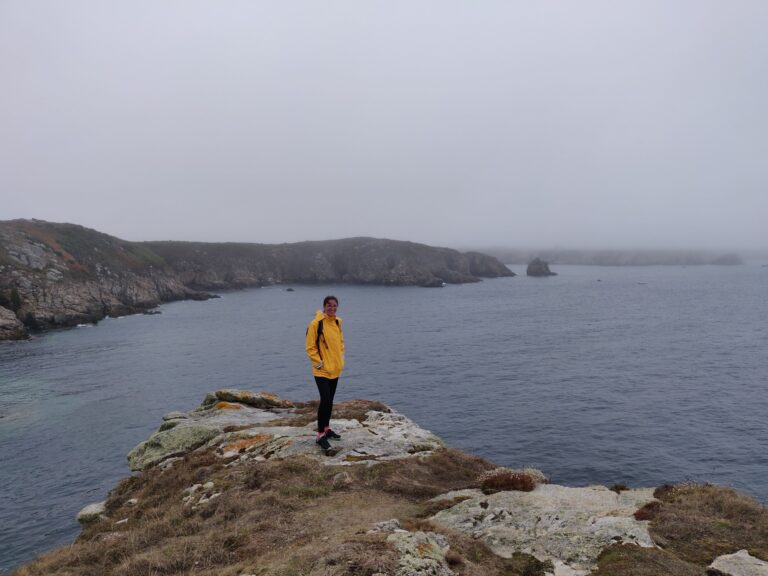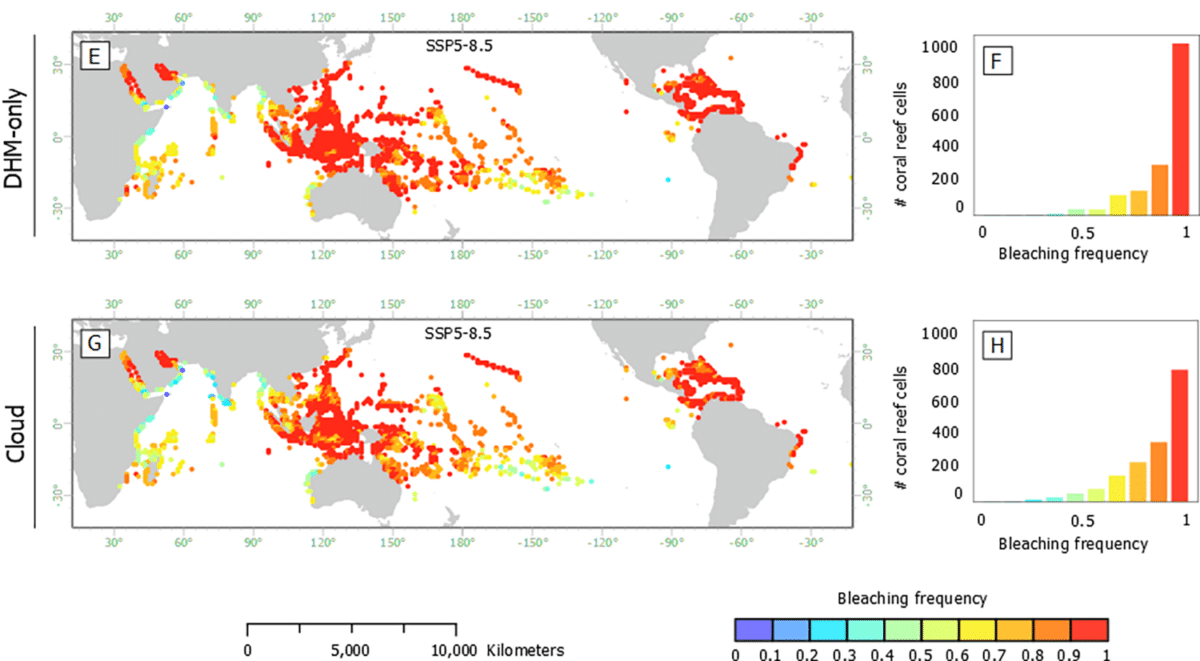Do clouds support us in coral protection?

Mystery in the Pacific: who saved coral reefs at the Society Islands?
Could the presence of clouds in the sky improve the health of coral reefs? This is the question that arose among scientists following an enigmatic event in French Polynesia. In 1998, all the corals in the Tuamotu Archipelago suffered from critical bleaching due to the heatwave brought by El Niño currents. A typical occurrence given the vulnerability of corals to temperature increases. However, what intrigued ecologists was the condition of the coral reefs in the Society Islands, near the Tuamotu Archipelago, which experienced the same warm currents… But they had bleached much less! Even more peculiar, 50 years of recorded data showed that the coral reefs in these two nearby zones always reacted similarly to regional thermal events [1]. How to explain, then, that corals reacted differently in waters of the same temperature?
Researchers realized that to solve this mystery, they needed to lift their heads from the water and look to the sky. After analyzing meteorological data, scientists observed an unprecedented cloud cover during the summer of ’98 above the Society Islands [1], precisely where the corals curiously resisted the heatwave. Thus, this puzzle piqued scientists’ interest in the previously neglected role of clouds in protecting coral reefs.
At the roots of bleaching, the ambiguous role of the Sun…
Generally, researchers focus on ocean temperature when studying coral bleaching. Rightly so, as its impact is scientifically indisputable (you can learn more about it in this article). However, research now allows us to understand that coral stress, leading to bleaching, can have various sources in the environment [2]. Solar radiation is one of these pressures.
Tropical reefs survive thanks to photosynthesis made by microalgae, called zooxanthellae, which live in symbiosis within corals and provide them with nutrients. Like plants, they require light to live. But this same light can become dangerous beyond a certain intensity threshold, as it becomes a source of stress for corals, stimulating their bleaching [3]. Thus, the scourge of bleaching does not solely originate from rises in ocean temperature but also from the intensity of sunlight [3]. Clouds, naturally filtering light, emerge as a solution to prevent coral bleaching.
The cloud shield finally recognized !
Given this observation, marine ecology and climatology researchers Dr. Gonzalez-Espinosa and Prof. Donner from the University of British Columbia in Canada recently proposed an improvement in global coral bleaching prediction algorithm. While previous models considered only temperature, they now incorporate cloud cover data [4]. After testing this new model on the field and comparing it to the old one, it’s clear that including cloud data allows for more accurate predictions! This provides undeniable evidence of the impact of clouds on coral bleaching [4].
Beyond enhancing our understanding of the forces involved in bleaching, this contribution opens new avenues for managing and protecting coral reefs. We can now identify high-potential refuge areas based on global cloud intensity [5]. For instance, a large area in the Pacific Ocean enjoys substantial and increasing cloud cover (Figure 1), providing a space where corals would have a high chance of thriving in the long term [6].

Figure 1. Projected trends in cloud cover from 2015-2100. Red illustrates a forecasted increase in cloud cover, and blue indicates a forecasted decrease. (Figure taken and adapted freely from Gonzalez-Espinosa & Donner, 2023 [5] ).
Facing climate uncertainty: global solidarity
Using the freshly updated prediction model, these same researchers projected estimates of the impact of climate change on coral reefs by integrating cloud cover [5]. Various predictive scenarios were tested (SSP scenarios), notably varying based on the intensity of future global warming.
In the most critical scenarios (SSP5-8.5), due to high human emissions, the protection provided by clouds is insufficient to prevent nearly total global bleaching (Figure 2) [5]. This eventuality would be a catastrophe for marine biodiversity and human living conditions.
Figure 2. Geographical distribution of projected bleaching intensity on reefs (Bleaching frequency) in the year 2050 in the pessimistic scenario (SSP5-8.5). Map E (DHM-only) is based on the model that considers only temperature, and map H (Cloud) is based on the model that considers both temperature and cloud cover. (Figure taken and adapted from Gonzalez-Espinosa & Donner, 2023 [5] ).
However, in more optimistic scenarios where we manage to drastically reduce our emissions and allow for a gradual adaptation of corals (SSP1), clouds can provide significant support. They could sustain livable environments and potentially slow down bleaching for several decades (Figure 3) [5].

Figure 3. Geographical distribution of projected bleaching intensity on reefs (Bleaching frequency) in the year 2050 in the optimistic scenario (SSP1-2.6). Map A (DHM-only) is based on the model that considers only temperature, and map C (Cloud) is based on the model that considers both temperature and cloud cover. (Figure taken and adapted from Gonzalez-Espinosa & Donner, 2023 [5] ).
While approaching these predictions is always worrisome, the discoveries made are not discouraging, quite the opposite! They underscore the usefulness and necessity of the action to fight climate change, the protection of endangered environments, and the active restoration of those already affected, such as coral reefs. The outcome of the Anthropocene is not predetermined, and the possible conclusions are diverse; this is what gives meaning to our actions.
Nature cannot regulate the magnitude of the damage we have caused in the short term on its own. However, if we commit to new policies that take care of life and respect the balances of our planet, then we have every reason to believe that the worst is avoidable. This study reminds us of the necessary cooperation between humans and the diversity of actors on this planet—whether they are animal, plant, or even meteorological—in order to pool our strengths to preserve our biosphere.
Take-Home Messages
- Corals are sensitive to high brightness, intensifying their bleaching.
- Clouds reduce light intensity, sparing corals from bleaching stress.
- Predictions of future global bleaching are more reliable when considering cloud cover, in addition to ocean temperature.
- The global cloud cover map allows us to identify areas with a high potential for coral refuge.
- If we intensify our efforts to preserve the planet and achieve less critical climate scenarios, clouds will play a significant role in preserving coral ecosystems.
Sources
- Mumby PJ, Chisholm JRM, Edwards AJ, Andrefouet S, Jaubert J. Cloudy weather may have saved Society Island reef corals during the 1998 ENSO event. Mar Ecol Prog Ser. 2001 Nov 5;222:209–16.
- Ban SS, Graham NAJ, Connolly SR. Evidence for multiple stressor interactions and effects on coral reefs. Glob Change Biol. 2014;20(3):681–97.
- Weis VM. Cellular mechanisms of Cnidarian bleaching: stress causes the collapse of symbiosis. J Exp Biol. 2008 Oct 1;211(19):3059–66.
- Gonzalez-Espinosa PC, Donner SD. Cloudiness reduces the bleaching response of coral reefs exposed to heat stress. Glob Change Biol. 2021;27(15):3474–86.
- González-Espinosa PC, Donner SD. Cloudiness delays projected impact of climate change on coral reefs. PLOS Clim. 2023 Feb 8;2(2):e0000090.
- Donner SD, Carilli J. Resilience of Central Pacific reefs subject to frequent heat stress and human disturbance. Sci Rep. 2019 Mar 5;9(1):3484.
Ces articles pourraient vous intéresser
An unexpected benefit for some Pacific corals of El Niño?
Over the past 30 years, marine heat waves have become increasingly frequent, intense and long, and it’s highly likely that this trend will increase with…
10 August 2023Tracking ocean temperatures in situ and from space
Written by: Florina Jacob and Laura Bastide Why monitor water temperature in coral restoration zones? Coral health is closely linked to water temperature. The…
26 June 2023
Sponsor Spotlight : Zepp Health
Tell us a bit about yourself 🙂 At Zepp Health, we’re on a mission to empower people to take control of their well-being. We…
19 June 2023
Donor spotlight : Charline Auvinet
Tell us a bit about yourself 🙂 After graduating a few years ago, I’m now a crime fiction editor. In this job, I have discovered…
17 January 2023

